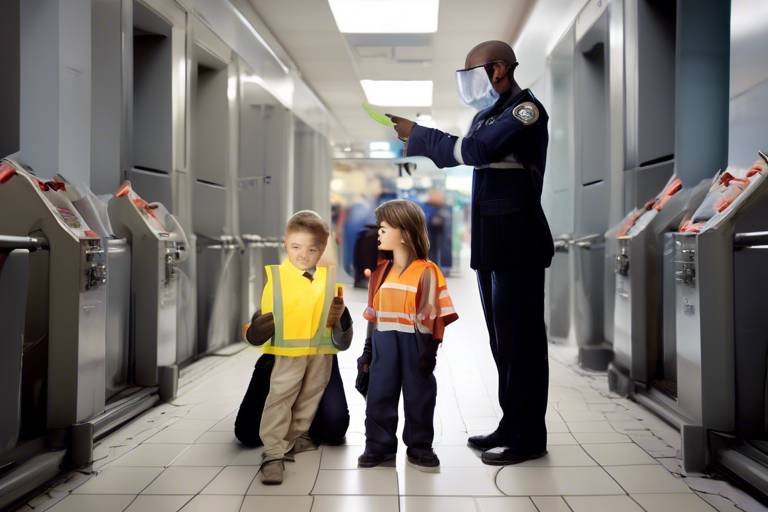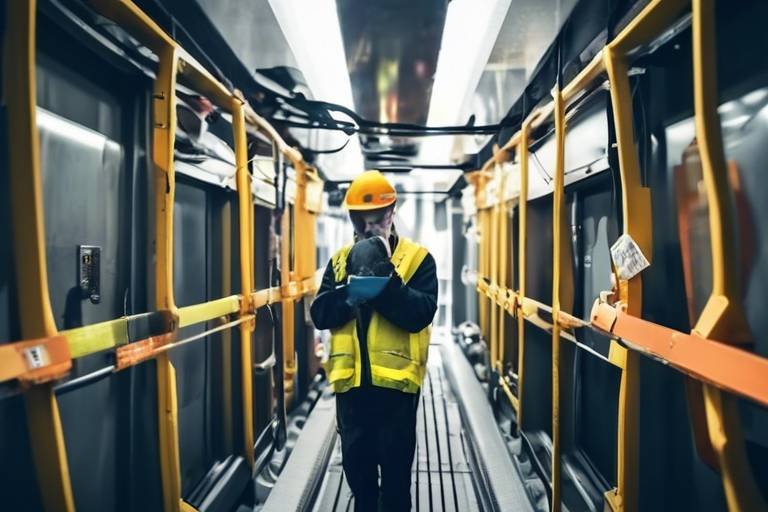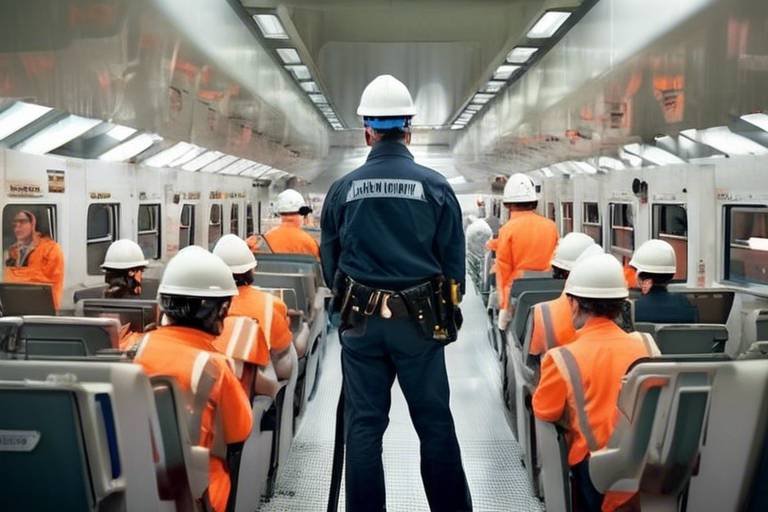Safety Measures and the Invisible Hand of Human Behavior
In today’s fast-paced world, safety measures are not just a set of rules to follow; they are a reflection of our inherent behavioral tendencies. The invisible hand of human behavior shapes how we perceive risks and respond to safety protocols. Have you ever wondered why some people consistently adhere to safety guidelines while others seem to ignore them completely? This article delves deep into the intricate dance between human psychology and safety practices, uncovering the factors that influence our actions in various environments.
Safety measures are designed to protect us, yet their effectiveness often hinges on the psychological motivations behind compliance. Understanding these motivations is crucial for organizations looking to enhance their safety protocols. It’s not enough to simply implement rules; companies must foster a culture of responsibility among their employees. Imagine a workplace where everyone feels personally invested in safety—not just because they have to, but because they genuinely want to. This shift in mindset can lead to a dramatic reduction in accidents and injuries.
But what drives this change in mindset? One key aspect is the concept of behavioral economics, which examines how our decision-making processes can be influenced by various factors. Often, individuals prioritize immediate rewards over long-term safety benefits. Consider this: when faced with a choice between a quick, enjoyable break and a tedious safety training session, which one would most people choose? This tendency to favor short-term gratification can undermine safety practices, leading to complacency and risky behavior.
To combat this, organizations can leverage the power of incentives. By creating a system that rewards safe behavior, companies can encourage employees to prioritize safety. For instance, offering bonuses or recognition for teams that meet safety targets can cultivate a proactive approach to risk management. It's like planting seeds in a garden; with the right nurturing, those seeds can grow into a thriving culture of safety.
However, it’s not just about rewards. Understanding the negative consequences of non-compliance is equally important. When employees recognize that ignoring safety measures could lead to serious repercussions—be it disciplinary action or, worse, injury—they are more likely to adhere to the protocols. This dual approach of positive reinforcement combined with an awareness of potential pitfalls creates a balanced strategy for enhancing safety behavior.
Moreover, social influences play a pivotal role in shaping our safety behaviors. Humans are inherently social creatures, and the dynamics within teams can either promote or deter adherence to safety protocols. Peer pressure can be a double-edged sword; while it can motivate individuals to comply with safety standards, it can also lead to risky behaviors if the group norm is lax. Organizations must cultivate a culture where safety is a shared value, encouraging employees to hold each other accountable.
As we explore the intersection of safety and human behavior, it becomes evident that effective training and education strategies are essential. Simply telling employees about safety measures is not enough; they need to understand their importance and how to implement them effectively. Interactive training programs can engage employees in meaningful ways, enhancing their retention of safety information. Think of it as turning a passive audience into active participants, where learning becomes a shared experience rather than a chore.
Finally, fostering a culture of continuous learning and improvement is vital. Safety practices should never be static; they need to evolve based on new insights and feedback from employees. Regular evaluations and updates to safety protocols ensure that they remain relevant and effective. This commitment to ongoing improvement not only enhances safety but also empowers employees, making them feel valued and involved in the process.
- What are the key factors influencing safety compliance?
Key factors include psychological motivations, incentives, social influences, and effective training programs.
- How can organizations promote a culture of safety?
Organizations can promote safety by implementing positive reinforcement strategies, encouraging open communication, and providing continuous training.
- Why is behavioral economics important in safety practices?
Behavioral economics helps us understand why individuals may prioritize short-term rewards over long-term safety, allowing organizations to tailor their approaches accordingly.
- What role do social dynamics play in safety behavior?
Social dynamics can significantly influence safety behavior, as peer pressure and group norms can either encourage or discourage adherence to safety protocols.

The Psychology of Safety Compliance
Understanding the psychological motivations behind safety compliance is crucial for organizations aiming to enhance their safety protocols. At its core, safety compliance isn't just about following rules; it’s about the mindset of the individuals involved. People are influenced by various psychological factors that dictate their behavior in the workplace. For instance, many employees might perceive safety regulations as mere formalities rather than essential practices. This perception can lead to a lack of engagement with safety measures, ultimately compromising workplace safety.
One of the primary factors affecting safety compliance is the perception of risk. If employees believe that the risks associated with their tasks are minimal, they are less likely to adhere to safety protocols. This is where the concept of cognitive bias comes into play. Cognitive biases can distort an individual's understanding of risk, leading them to underestimate potential hazards. For example, the optimism bias leads people to believe that they are less likely to experience negative outcomes compared to others. Consequently, they may disregard safety measures, thinking, "It won't happen to me."
Furthermore, the social environment within an organization significantly influences safety compliance. If a workplace culture prioritizes productivity over safety, employees may feel pressured to cut corners. This can create a dangerous cycle where safety measures are seen as impediments to getting the job done quickly. Conversely, a culture that promotes safety as a shared responsibility can lead to increased compliance. Employees are more likely to adhere to safety protocols when they see their peers doing the same. It’s a classic case of social proof—when individuals observe others following safety measures, they are more inclined to do so themselves.
To effectively foster a culture of safety compliance, organizations must address these psychological factors head-on. This can be achieved through comprehensive training programs that not only inform employees about safety protocols but also engage them on a psychological level. By incorporating elements that address cognitive biases and social influences, organizations can create a more robust safety culture. For instance, using real-life scenarios in training can help employees understand the practical implications of safety measures, making the risks more tangible and relatable.
In conclusion, the psychology of safety compliance is multifaceted and deeply rooted in human behavior. By recognizing the psychological barriers to compliance, organizations can implement targeted strategies that promote a culture of safety. This involves not only educating employees about the importance of safety measures but also cultivating an environment where safety is prioritized and valued. After all, a safe workplace is not just about rules; it's about the people who make those rules come to life.

Behavioral Economics in Safety
Behavioral economics dives deep into the fascinating world of human decision-making, shedding light on why we often act against our best interests, especially when it comes to safety. Imagine you're at work, and there's a safety protocol that you know is crucial for your well-being. Yet, you find yourself skipping it because it feels inconvenient or because the immediate reward of finishing your task faster seems more appealing than the distant threat of an accident. This is a common scenario that illustrates the tug-of-war between short-term gratification and long-term safety.
At the heart of behavioral economics is the understanding that humans are not always rational actors. We are influenced by biases, emotions, and social factors that can cloud our judgment. For instance, the availability heuristic plays a significant role in how we perceive risk. If we haven't experienced an accident recently, we might underestimate the likelihood of one occurring. This perception can lead to complacency in following safety measures. Organizations must recognize these psychological barriers and address them to foster a culture of safety.
One of the key insights from behavioral economics is the idea of loss aversion, which suggests that people are more motivated to avoid losses than to achieve gains. This principle can be harnessed in safety practices by emphasizing the potential negative outcomes of non-compliance. For example, instead of merely stating that following safety protocols leads to fewer accidents, organizations could highlight the severe consequences that could arise from neglecting these measures. By framing safety compliance in terms of avoiding losses, employees may be more inclined to adhere to regulations.
To illustrate this further, consider the following table that compares traditional safety messaging with a loss aversion approach:
| Traditional Safety Messaging | Loss Aversion Approach |
|---|---|
| “Following safety protocols ensures a safe workplace.” | “Neglecting safety protocols could lead to serious injuries or even fatalities.” |
| “Wear your helmet to protect yourself.” | “Not wearing a helmet could result in life-altering injuries.” |
Moreover, the concept of social proof can also be a powerful motivator in safety compliance. People often look to others when making decisions, especially in uncertain situations. If employees see their peers consistently following safety protocols, they are more likely to do the same. Organizations can leverage this by creating visible safety champions or teams that exemplify best practices, thereby fostering a culture where safety behaviors are normalized and celebrated.
In conclusion, understanding the principles of behavioral economics can significantly enhance safety practices within organizations. By recognizing the psychological factors at play, companies can tailor their safety messaging and training to better align with human behavior. This approach not only improves compliance but also creates a safer work environment where employees feel empowered to prioritize their safety and that of their colleagues.

The Role of Incentives
Incentives play a crucial role in shaping safety behavior within organizations, acting as the invisible hand that guides employees towards compliance and proactive risk management. Imagine a workplace where every employee feels motivated to adhere to safety protocols not because they fear punishment, but because they genuinely want to contribute to a safer environment. This is the power of well-structured incentives.
When we talk about incentives, we often think of monetary rewards, but the reality is much broader. Incentives can be classified into two primary categories: extrinsic and intrinsic. Extrinsic incentives include bonuses, gift cards, or even public recognition for maintaining a safe work environment. On the other hand, intrinsic incentives stem from personal satisfaction and pride in one’s work. For example, when employees understand the direct impact of their actions on their colleagues’ safety, they may feel a sense of responsibility that drives them to comply with safety measures.
Furthermore, the effectiveness of incentives is largely influenced by how they are communicated and implemented. If employees perceive incentives as genuine and aligned with their values, they are more likely to embrace them. Consider this: when a company launches a safety competition where teams earn points for safe practices, the excitement and camaraderie can foster a culture of safety that transcends mere compliance. This leads to a scenario where safety becomes a shared goal, rather than a set of rules to follow.
However, it’s important to strike a balance. Overemphasizing extrinsic rewards can sometimes backfire, leading employees to focus solely on the rewards rather than the underlying importance of safety. This is where the concept of positive reinforcement comes into play. By recognizing and rewarding safe behaviors, organizations can create a positive feedback loop that encourages employees to internalize safety practices.
To illustrate the impact of incentives on safety behavior, consider the following table that outlines various incentive strategies and their potential effects:
| Incentive Type | Description | Potential Effect |
|---|---|---|
| Monetary Rewards | Bonuses for achieving safety milestones | Increases motivation and compliance |
| Recognition Programs | Employee of the Month for safety adherence | Boosts morale and encourages peer support |
| Safety Competitions | Teams compete for the safest work area | Fosters teamwork and a culture of safety |
| Training Opportunities | Access to advanced safety training for compliant teams | Enhances skills and knowledge, promoting long-term safety |
In conclusion, the role of incentives in promoting safety behavior cannot be overstated. By thoughtfully designing incentive programs that resonate with employees, organizations can cultivate a culture of safety that not only enhances compliance but also inspires individuals to take ownership of their actions. As we navigate the complexities of human behavior, let’s remember that the right incentives can turn safety from a mere obligation into a shared value, creating a more secure workplace for everyone.

Positive Reinforcement Techniques
When it comes to enhancing safety behavior in the workplace, can be game changers. Imagine a scenario where employees are not just following safety protocols because they fear penalties, but rather because they feel genuinely recognized and rewarded for their adherence. This shift in mindset can transform the workplace culture into one that prioritizes safety as a shared responsibility. By implementing strategies that acknowledge and reward safe practices, organizations can create an environment where employees feel motivated to comply with safety measures.
Positive reinforcement can take many forms, from verbal praise to tangible rewards. For instance, consider a company that introduces a monthly safety award for the team that demonstrates the best safety practices. This not only encourages healthy competition but also fosters a sense of camaraderie among employees. When individuals see their peers being rewarded for safe behavior, it creates a ripple effect, encouraging others to follow suit. Additionally, public recognition during team meetings can significantly boost morale and motivate employees to remain vigilant about safety protocols.
Moreover, implementing a point system can also be an effective way to encourage safe behavior. Employees can earn points for adhering to safety measures, participating in safety training, or reporting potential hazards. These points can then be redeemed for various rewards, such as gift cards, extra time off, or even company merchandise. This tangible incentive not only motivates employees but also reinforces the idea that safety is a priority within the organization.
Furthermore, it’s essential to ensure that the reinforcement techniques are consistent and fair. If employees perceive the reward system as biased or arbitrary, it can lead to feelings of resentment and disengagement. To avoid this, organizations should establish clear criteria for how rewards are earned and ensure that all employees have an equal opportunity to participate. Transparency in the process can foster trust and encourage more employees to engage in safe practices.
In conclusion, positive reinforcement techniques are not just about handing out rewards; they are about creating a culture where safety is valued and recognized. By shifting the focus from punitive measures to rewarding safe behavior, organizations can cultivate a proactive approach to safety that benefits everyone. When employees feel appreciated for their contributions to a safe work environment, they are more likely to remain committed to following safety protocols, ultimately leading to a safer workplace for all.
- What are positive reinforcement techniques? Positive reinforcement techniques are strategies used to encourage desired behaviors by providing rewards or recognition for those behaviors.
- How can positive reinforcement improve safety in the workplace? By rewarding safe practices, employees are more likely to engage in and prioritize safety, leading to a more secure work environment.
- What types of rewards can be used for positive reinforcement? Rewards can range from verbal praise and public recognition to tangible items like gift cards or extra time off.
- Is it important to have a fair reward system? Yes, fairness and transparency in the reward system are crucial to maintaining employee trust and motivation.

Negative Consequences of Non-Compliance
When it comes to safety measures in any environment, non-compliance can have serious repercussions. Whether in the workplace, at home, or in public spaces, ignoring safety protocols doesn't just put individuals at risk; it can also endanger others. Imagine a construction site where safety gear is optional. The result? Increased accidents, injuries, and even fatalities. This scenario is not just hypothetical; it's a reality that many organizations face when safety regulations are not strictly adhered to.
One of the most immediate consequences of non-compliance is the potential for injury or loss of life. Statistics show that workplaces with lax safety standards often experience higher rates of accidents. For instance, according to the Occupational Safety and Health Administration (OSHA), businesses that fail to comply with safety regulations can see their injury rates soar by as much as 50%. This not only affects the individuals directly involved but also creates a ripple effect that impacts families, coworkers, and the community.
Furthermore, non-compliance can lead to significant financial repercussions for organizations. The costs associated with workplace accidents can be staggering, including:
- Medical expenses for injured employees
- Legal fees from lawsuits
- Increased insurance premiums
- Loss of productivity due to injuries
- Potential fines from regulatory bodies
To illustrate, consider a company that experiences a major accident due to non-compliance. Not only does it have to deal with the immediate fallout, but it may also face investigations and fines that can reach into the hundreds of thousands of dollars. This financial burden can cripple a business, especially smaller ones that may not have the resources to absorb such losses.
There’s also the reputational damage that comes with non-compliance. Companies that are known for poor safety records may struggle to attract top talent, as potential employees often seek out workplaces that prioritize safety and well-being. Moreover, customers may choose to take their business elsewhere, preferring to support organizations that demonstrate a commitment to safety. In today’s competitive market, reputation is everything, and a single incident can tarnish years of hard work.
Lastly, the psychological impact of non-compliance should not be underestimated. Employees who witness or experience unsafe practices may develop a culture of fear and distrust. This can lead to decreased morale, lower job satisfaction, and ultimately, higher turnover rates. When employees feel unsafe or undervalued, they are less likely to engage fully with their work, which can further exacerbate safety issues.
In summary, the negative consequences of non-compliance are multifaceted. From physical and financial repercussions to reputational damage and psychological effects, the stakes are incredibly high. Organizations must recognize that adhering to safety measures is not just a regulatory requirement; it’s a moral obligation to protect their employees and the broader community.
- What are the most common consequences of non-compliance with safety regulations?
Common consequences include injury or loss of life, financial penalties, and damage to the organization's reputation. - How can organizations improve compliance with safety measures?
Implementing effective training programs, fostering a culture of safety, and using incentives can significantly improve compliance. - Why is psychological motivation important in safety compliance?
Understanding psychological motivations helps organizations tailor their safety protocols to better resonate with employees, enhancing adherence.

Social Influences on Safety Behavior
When it comes to safety behavior, one cannot underestimate the power of social influences. Just think about it: we are inherently social creatures, and our actions are often swayed by those around us. Whether it’s at work, school, or even in our personal lives, the behaviors of our peers can significantly shape our own actions. This phenomenon is often referred to as social conformity, where individuals adjust their behaviors to align with the group norms. Imagine walking into a room where everyone is wearing a helmet; the likelihood of you putting one on too increases dramatically, doesn’t it?
Moreover, the dynamics of peer pressure can play a pivotal role in determining how seriously safety measures are taken. If a group of employees consistently disregards safety protocols, new members may feel compelled to follow suit, thinking, “If they’re not worried, why should I be?” This creates a ripple effect that can undermine even the most stringent safety regulations. Conversely, when a culture of safety is championed by influential team members, it can inspire others to adopt similar attitudes towards compliance. It’s like a chain reaction of positive behavior that can lead to a safer environment for everyone.
To illustrate this concept further, let’s consider a workplace scenario. Imagine a factory where safety gear is mandatory, but a few employees choose to ignore this rule. Others might think, “They’ve been here longer; they must know what they’re doing.” This thought process can lead to a dangerous situation where safety becomes an afterthought. On the other hand, if those same employees see their peers actively engaging in safe practices—like wearing protective gear and following protocols—they’re more likely to adopt those behaviors themselves.
Social norms can be incredibly powerful. Research indicates that when individuals perceive that their peers prioritize safety, they are more likely to engage in safe behaviors themselves. This is where leadership plays a critical role. Leaders who visibly prioritize safety can set a standard that others feel compelled to follow. They create an environment where safety is not just a policy but a shared value. This can be achieved through various means, such as:
- Regular safety meetings that highlight the importance of compliance.
- Creating opportunities for employees to share their safety experiences and concerns.
- Recognizing and rewarding teams that demonstrate exceptional safety practices.
Ultimately, the social influences on safety behavior underscore the importance of building a strong safety culture within organizations. When individuals feel supported by their peers and see that safety is a collective priority, they are more likely to comply with safety measures. It’s about creating an environment where everyone looks out for one another, fostering a sense of responsibility that goes beyond individual actions. In this way, social dynamics can either be a barrier to safety or a powerful ally in promoting a culture of compliance.
Q: How can organizations leverage social influences to improve safety behavior?
A: Organizations can encourage positive social influences by promoting teamwork, recognizing safe practices publicly, and fostering open communication about safety concerns.
Q: What role does leadership play in shaping safety behavior?
A: Leadership sets the tone for safety culture. When leaders prioritize safety and model safe behaviors, employees are more likely to follow suit.
Q: Can peer pressure have a positive impact on safety behavior?
A: Yes, positive peer pressure can encourage individuals to adhere to safety protocols, especially when they see their colleagues valuing safety.

Training and Education Strategies
In today's fast-paced world, where safety is paramount, effective training and education strategies are not just optional; they are essential. Organizations must recognize that simply implementing safety measures isn't enough. It’s like putting a lock on a door but forgetting to teach people how to use it. The key lies in ensuring that individuals not only understand these measures but also appreciate their importance. When employees comprehend the 'why' behind safety protocols, they are more likely to embrace them wholeheartedly.
One of the most impactful ways to achieve this is through interactive training programs. These programs go beyond traditional lectures and textbooks; they engage employees in hands-on activities that simulate real-life scenarios. Imagine a fire drill where employees are not just instructed on what to do but are actively participating in the evacuation process. This kind of training sticks with people far more than a PowerPoint presentation ever could. By immersing employees in realistic situations, they can develop a sense of urgency and responsibility towards safety.
Moreover, the inclusion of technology in training can elevate the learning experience. Virtual reality (VR) and augmented reality (AR) can create immersive environments where employees can practice safety protocols without any real-world consequences. For instance, using VR to simulate hazardous situations can prepare workers for emergencies they might face on the job. This approach not only enhances retention of safety information but also boosts confidence among employees, making them feel more prepared to handle potential risks.
Another critical aspect of training is the concept of continuous learning and improvement. Safety practices should never be static; they must evolve with new insights and experiences. Organizations should foster a culture where feedback is encouraged, and safety protocols are regularly reviewed and updated. This could involve periodic refresher courses or workshops that address emerging safety concerns or new regulations. By creating an environment of continuous improvement, employees will understand that safety is a dynamic process, and their participation is vital.
To further enhance the effectiveness of training, organizations should also consider incorporating peer-led training sessions. When employees train each other, it fosters a sense of camaraderie and shared responsibility. It can also break down barriers between different levels of staff, making safety a collective goal rather than just a top-down mandate. Additionally, employees may feel more comfortable asking questions or discussing concerns with their peers, leading to a deeper understanding of safety practices.
In conclusion, the strategies employed in training and education can significantly impact the effectiveness of safety measures within an organization. By focusing on interactive training, leveraging technology, promoting continuous learning, and encouraging peer-led sessions, organizations can create a robust safety culture. After all, when employees feel equipped and empowered, they are more likely to take ownership of their safety and the safety of those around them.
- What are interactive training programs?
Interactive training programs involve engaging activities that allow employees to practice safety protocols in realistic scenarios, enhancing learning and retention. - How can technology improve safety training?
Using technologies like VR and AR can create immersive training experiences that prepare employees for real-life situations without any risk. - Why is continuous learning important in safety training?
Continuous learning ensures that safety practices are updated regularly, adapting to new insights and regulations, which helps maintain a high safety standard. - What is the benefit of peer-led training?
Peer-led training fosters teamwork and encourages open communication, making it easier for employees to discuss safety concerns and learn from each other.

Interactive Training Programs
When it comes to enhancing safety practices in any organization, are a game changer. Imagine a workplace where employees are not just passive recipients of information but active participants in their learning journey. This approach transforms traditional training into an engaging experience that not only informs but also empowers individuals. By incorporating elements such as simulations, role-playing, and hands-on activities, organizations can create an environment where safety protocols are not just memorized but truly understood and internalized.
One of the key benefits of interactive training is its ability to cater to different learning styles. Not everyone absorbs information the same way; some learn best through visual aids, while others prefer auditory or kinesthetic methods. By offering a variety of training modalities, organizations can ensure that all employees have the opportunity to grasp essential safety concepts. For instance, visual learners might benefit from videos and infographics, while hands-on learners could thrive in a scenario-based training environment where they can practice skills in real time.
Moreover, interactive training programs can significantly increase retention rates. Studies have shown that individuals are more likely to remember information that they actively engage with rather than passively consume. This is akin to the difference between reading a recipe and actually cooking a meal. When employees participate in interactive training, they are essentially 'cooking' the safety protocols, which helps them remember the steps involved much better. This level of engagement not only boosts knowledge retention but also fosters a sense of ownership and responsibility towards safety practices.
To illustrate the impact of interactive training, consider the following table that compares traditional training methods with interactive approaches:
| Training Method | Engagement Level | Retention Rate | Real-World Application |
|---|---|---|---|
| Traditional Lecture | Low | 30% | Limited |
| Interactive Simulation | High | 70% | Extensive |
| Hands-On Workshop | Very High | 80% | Direct |
As the table highlights, interactive training not only enhances engagement but also significantly boosts retention rates, making it a vital component in safety education. Additionally, these programs encourage teamwork and communication among employees. When individuals work together in a training setting, they develop a sense of camaraderie and shared responsibility, which can spill over into their daily work routines. This collaborative spirit is crucial when it comes to adhering to safety measures, as team members are more likely to support and hold each other accountable.
In conclusion, investing in interactive training programs is not just about ticking a box on a compliance checklist; it's about fostering a culture of safety that resonates throughout the organization. By empowering employees through engaging and effective training, organizations can ensure that safety becomes a fundamental aspect of their workplace ethos. After all, when people feel involved and invested in their learning, they are more likely to take the necessary precautions to protect themselves and their colleagues. So, why not make safety training an experience rather than a chore?
- What are interactive training programs? Interactive training programs are educational sessions that involve active participation from learners, utilizing simulations, role-playing, and hands-on activities.
- How do interactive training programs improve safety compliance? These programs enhance engagement and retention, leading to better understanding and application of safety protocols in real-world situations.
- Can interactive training cater to different learning styles? Yes, interactive training can incorporate various methods to accommodate visual, auditory, and kinesthetic learners.
- What are the benefits of team-based training? Team-based training fosters collaboration, accountability, and a shared commitment to safety among employees.

Continuous Learning and Improvement
In today's rapidly changing work environment, the concept of is not just a buzzword; it's a vital component of ensuring workplace safety. Imagine a world where every employee is not only aware of safety protocols but actively engaged in enhancing them. This vision can become a reality when organizations foster a culture that prioritizes ongoing education and improvement. By instilling a mindset of lifelong learning, companies can empower their workforce to recognize potential hazards and implement effective solutions.
One of the most effective ways to promote continuous learning is through regular training sessions that go beyond the basics. These sessions should be interactive, engaging, and tailored to the specific needs of the employees. For instance, incorporating real-life scenarios into training can help employees understand the practical implications of safety measures. When workers can relate to the training material, they are more likely to absorb the information and apply it in their daily routines.
Moreover, organizations can utilize various tools and techniques to facilitate continuous improvement. For example, feedback loops can be established where employees can share their experiences and suggestions regarding safety practices. This not only helps in identifying areas for improvement but also makes employees feel valued and heard. When people see that their input leads to real changes, they become more invested in the safety culture of their workplace.
To take it a step further, companies can implement a structured framework for continuous improvement. This framework could include:
- Regular Safety Audits: Periodic assessments of safety protocols can highlight areas that need attention.
- Employee Involvement: Encourage staff to participate in safety committees or focus groups.
- Training Updates: Regularly update training materials to reflect the latest safety standards and technologies.
- Recognition Programs: Acknowledge and reward employees who contribute to safety improvements.
By integrating these elements into the organizational culture, companies can create an environment where safety is not just a requirement but a shared responsibility. When employees feel empowered to contribute to safety discussions, they are more likely to take ownership of their roles and adhere to safety measures. This collective effort leads to a more resilient workplace, where safety practices are continually evaluated and refined.
In conclusion, the journey towards a safer workplace is ongoing and requires dedication from both management and employees. By promoting continuous learning and improvement, organizations can ensure that safety measures evolve with the times, ultimately leading to a safer and more productive work environment.
- What is continuous learning in the context of workplace safety? Continuous learning involves ongoing training and education to ensure employees are aware of and engaged in safety practices.
- How can organizations encourage continuous improvement in safety? Organizations can encourage continuous improvement by implementing regular training, feedback mechanisms, and employee recognition programs.
- Why is employee involvement important for safety culture? Employee involvement fosters a sense of ownership and accountability, leading to higher compliance with safety measures.
- What role do training updates play in workplace safety? Training updates ensure that employees are informed about the latest safety standards and practices, which helps in reducing risks.
Frequently Asked Questions
- What are the key psychological factors that influence safety compliance?
Understanding psychological factors like motivation, perception of risk, and individual responsibility can significantly enhance safety compliance. When employees feel a personal connection to safety measures, they are more likely to adhere to protocols.
- How does behavioral economics relate to safety practices?
Behavioral economics examines how people make decisions, often prioritizing immediate rewards over long-term safety. This insight helps organizations design better safety measures that align with human behavior, encouraging safer choices.
- What role do incentives play in promoting safety behavior?
Incentives are powerful tools that can motivate employees to comply with safety regulations. By offering rewards for safe practices, organizations can cultivate a proactive approach to risk management, making safety a shared responsibility.
- Can you explain positive reinforcement techniques in safety?
Positive reinforcement involves rewarding safe behavior, which can significantly boost compliance. When employees receive recognition for following safety protocols, it encourages them to continue these behaviors, fostering a culture of safety.
- What are the consequences of non-compliance with safety measures?
Non-compliance can lead to severe consequences, including accidents, injuries, and legal repercussions. Understanding these risks is crucial for motivating individuals to adhere to safety protocols and regulations.
- How do social influences affect safety behavior?
Social dynamics, such as peer pressure and group norms, play a significant role in shaping safety behavior. When safety is prioritized within a group, individuals are more likely to conform and adhere to safety practices.
- Why is training and education important for safety?
Effective training and education ensure that individuals understand the importance of safety measures and know how to implement them. This knowledge is vital for creating a safe work environment and reducing risks.
- What are interactive training programs?
Interactive training programs engage employees through hands-on activities, discussions, and simulations. This approach enhances retention of safety information and improves compliance in real-world scenarios.
- How can organizations foster a culture of continuous learning in safety?
A culture of continuous learning encourages regular evaluation and updating of safety practices. This not only keeps safety measures effective but also empowers employees to take an active role in improving workplace safety.



















